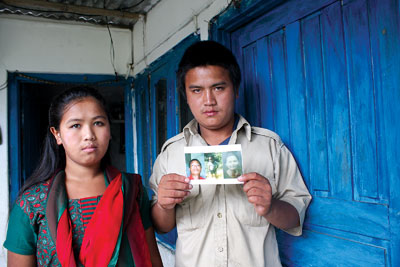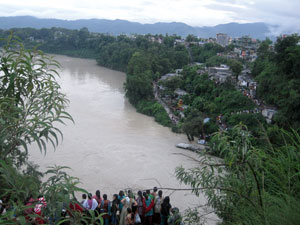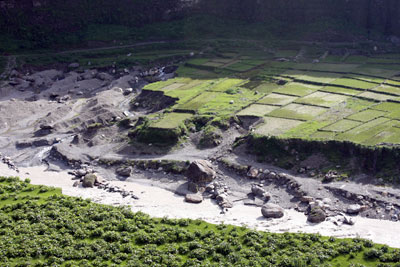 PIC: SIAN CHOO TONG ONLY MEMORIES: Chahana Pun with her brother Amrit Pun holding a picture of their parents and baby brother who were among the nearly 80 people washed away by the flashflood on the Seti on 5 May. |
On the morning of 5 May, villagers on the northern edge of Pokhara heard an unusual noise from the Seti. Within hours floodwaters swept away settlements, farmlands and cattle along Kharapani village killing 20 and displacing hundreds.
Twenty-year-old Amrit Pun and 13-year-old Chahana Pun's parents and baby brother along with 10 other villagers from Leknath municipality were at Sardi Khola that Saturday taking hot spring baths. Their parents and brother never returned.
"We weren't expecting the flood, because it wasn't the monsoon season yet," explained Amrit, wiping tears from his eyes. Many sand miners and tourists who had come to bathe in the hot springs lost their lives after multiple avalanches triggered a sudden blockage in the Seti.
 CANDICE NEO Heavy rainfall caused another Seti flood on 11 July, as seen below from Ramghat. |
Chahana is studying in sixth grade at a school 30 km away from her home. Funded by a Japanese NGO, the school provides free education and housing to children affected by the flood. Chahana hopes to study in Japan after completing her SLC exams.
Despite the ordeal, the children remain optimistic. Amrit said: "I know our parents will never come back. But our neighbours have been extremely helpful and have taken good care of us during this difficult time. And I am hopeful that once I get a job, I will be able to take care of myself and my sister."
While Amrit, Chahana and hundreds of other flood victims try to rebuild their lives, heavy rainfall on 11 July set off another flood on the Seti. The river swelled to 15 metres, submerging squatter settlements along the bank in a muddy ooze as the rains washed down the sediments of the May flood from the mountains.
 PICS: SIAN CHOO TONG KNEE DEEP: Water has clogged up around Chahana and Amrit's house after the downpour on 11 July |
 The Seti rose again after heavy rainfall |
 Streets around Pokhara were innundated |
Read also:
After the flood
See also:
Eye in the sky
Russian pilot of sight-seeing flight radioed Pokhara about the Seti flood and possibly saved many lives


